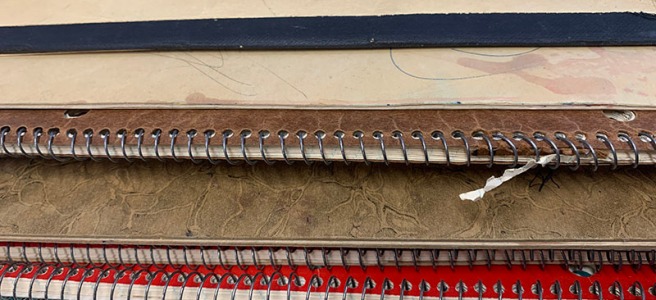
I’m standing here, next to a life-sized cut out of Laura Ingalls Wilder, in front of her side porch and the door that leads to her farmhouse kitchen on Rocky Ridge Farm, now known as the Laura Ingalls Wilder Historic Home and Museum.
Visiting Rocky Ridge has been on my personal to-do list since I first found out that she’d lived on this section of Ozark land for more than 60 years. Wilder traveled extensively as a child across the Midwest as her family looked for a place to settle down and prosper, and each of the places they stopped and lived has become part of the “tour” of Wilder sites. With this stop at Rocky Ridge today, I’ve been to every site but the one in upstate New York featured in Farmer Boy.
It’s hard, sometimes, to process the emotions that come from fulfilling a long-held dream. I brought my sister and my little girls along for this trip, and having them there added to my joy at finally walking on Wilder’s land, touring her house, and viewing her things, lovingly preserved as it was when she died on Feb. 10, 1957 at the age of 90. As our docent explained during our tour, Wilder’s daughter, Rose, locked the house three days after Wilder’s death, and it remained in stasis until three months later, when, with Rose’s permission and the formation of the non-profit society that currently maintains it, the home opened to the public for tours.
I’m grasping for words to express how it felt to stand in Laura’s kitchen, seeing the pipes that Almanzo had installed himself to bring their spring into the house so she’d have running water with which to cook. One counter held her flour sifter, a board, rolling pin, and ceramic bowl, looking for all the world that she’d stepped away for a moment from baking project. Her blue willow-patterned dishes, everyday favorites, gleam from an open cupboard. The green linoleum that tops the short counters–made by Almanzo to accommodate her petite size–is original.
Everything in the house remains as she left it in 1957. Through the kitchen to the dining room, visitors can spot Rose’s ladder stairs to her upstairs bedroom on their left. The dining room table, bought by Rose to furnish the Rock House in 1929, had been brought back to the main farm in 1936, when the couple moved back in after spending eight years in the Rock House that Rose had built for them. On a shelf built as a triangle to fit snugly in the corner above a heater, the clock that Almanzo traded a load of hay for during their first Christmas still tells the time, carefully wound every morning by the docents in charge for the day.
I found it hard not to touch things as I went through the house. (My preschoolers were very good at keeping their hands in their pockets. They started teasing me about doing the same, and made me giggle.) But it was hard! Most tables and dressers held a lace doilies, knitted by Laura in a favored “pineapple” pattern. Her sewing box sat under a table, ready for use; her nightgown lay across her bed. Her desk held letters from publishers and others; her parlor window seat held three pillows, one of which was embroidered by Angeline Day Wilder, Almanzo’s mother.
Laura’s library, Almanzo’s canes, Rose’s organ, and most of all, their space, lovingly built, kept, and maintained, echoed with the remembrances of their lives, lived.
The home is the showpiece that Laura intended, made from materials taken right off the farm, and emerging into view from the road at the perfect spot coming out from town. It’s a lovely home, and I can easily see why she didn’t want to be parted from it for long.
The museum by Rocky Ridge, now down from the house in its own space with its own parking lot, continued the collection of things that once belonged to many of the people in the Little House. Pa’s fiddle, once owned by Charles Ingalls, has pride of place in the gallery. But we can also see Caroline (Ma) Ingalls’ mother-of-pearl handled pen, Mary’s Braille slate, and Rose’s writing desk. I had to send my little girls, who had been very patient but were getting restless, with my sister into the attached store early so I could be sure to view it all: every. single. thing.
Of course, I spent way too much money in the gift shop. But I also signed stock; they had several copies of my first book, The Rediscovered Writings of Rose Wilder Lane, Literary Journalist. I also spotted it in the Rock House in a display about Rose, which I found flattering.
We had a very late lunch in town, then took pictures in Mansfield’s town square and visited the Wilder and Lane graves in the cemetery. I could have spent days, but one day was enough to view absolutely everything.
I highly recommend a stop if you’re in the area. My little girls, at 4 and 5, found it to be a fun experience. Walking the trails around the farm gave them plenty of exercise; somehow, and I realize how silly this is, I hadn’t realized that a farm in the mountains would be on such a significant incline. We were prepared with good shoes, so it didn’t trip us up. If mobility is an issue for you, don’t worry; handicapped parking is available at the museum, the main farm house, and the Rock House. We chose, mostly, to walk. We avoided the over-the-hill walking trail between the Rock House and the farm house, but otherwise walked everywhere.
I sent my mother a selfie of my sister, my little girls, and me, all smiling, pink-cheeked, from Laura’s front porch. She texted back, “Cool! Do you feel different?”
I gotta say, “Kinda, yeah.”

